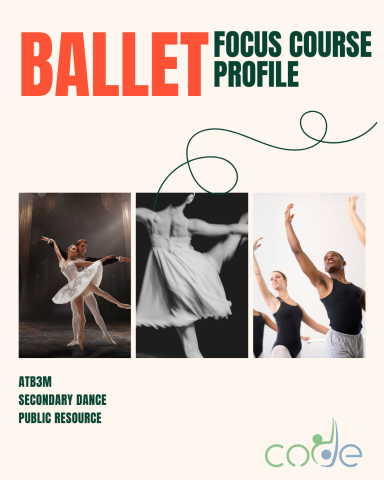This course emphasizes the development of students’ artistry, improvisational and compositional skills, and technical proficiency in global dance genres. Students will apply dance elements, techniques, and tools in a variety of ways, including performance situations; describe and model responsible practices related to the dance environment; and reflect on how the study of dance affects personal and artistic development. This course will focus on Ballet.
Course Profile

Course Overview
This course will allow students to develop their technical abilities in ballet as well as expand their knowledge of aesthetics, culture, health and wellness. They will expand their understanding of ballet by studying one or more ballet techniques (e.g.: Cecchetti syllabus, R.A.D syllabus, etc.). Students will expand their understanding of ballet terminology and their ability to communicate using this terminology in the creative and critical analysis processes. Students will examine the history of ballet and learn about its development from the 1500's to the present. Students will be challenged to reflect about the purpose and place of Ballet in the contemporary dance world and from a global perspective.
Scope & Sequence
Unit Descriptions
Unit 1: Etiquette, Pedagogy and the Technique of Ballet (40 hours)
Students will develop an understanding and practice of R.A.D. and/or Cecchetti technique to further develop their technical skills. It is recommended that this unit be delivered over the entire course. Safe dance practices will be observed so that a secure dance environment is available for all students, regardless of level of experience with this dance form. Students will expand their dance vocabulary and knowledge of ballet terms. The critical analysis process will be used to examine the components of a healthy dance practice, and to develop the students’ ability to be reflective of their own dance practices and body image.
Unit 2: Ballet: An Historical Perspective (20 hours)
In this unit students will follow the transformation of ballet from the beginning of its existence in the 1500’s to its current status as a significant dance form in contemporary society. Students will explore the cultural roots of ballet and learn about key dancers and choreographers throughout history as well as its traditional link with classical music. Students will learn about Jean-Georges Noverre, a french ballet dancer turned choreographer, who helped codify what is now modern day ballet. They will study ballet's timeline and learn about the different eras of ballet dance and the most significant events (the first ballet, Louis X1V (Sun King), the first performance by a professional female dancer at a theatre, the first full-length ballet on pointe, the Pas de Quatre, The Dying Swan for Anna Pavlova, The Ballet Russes, etc) Historical understanding will be used to make predictions about the future role of ballet in the dance and performance world.
Unit 3: Ballet in Contemporary Society (20 hours)
Students will observe a variety of professional and non-professional ballet performances, live and on video. Students may visit local studios to observe classes and to understand the role of ballet in dance training, including university or college reach-ahead experiences. Students will engage in critical thinking about the changing nature of ballet, the definition of a classical dance education, stereotypes within and about ballet, cultural inclusiveness, elitism and exclusivity. Particular attention will be given to the evolving role of ballet in contemporary society. Students will develop an awareness of the dancers, choreographers, companies, and career opportunities that exist within the existing global ballet community. Students will reflect on their learning in a way that is personally meaningful (i.e.: journal writing by hand or on a computer, video reflections, scrapbooking, blogging, etc.) to document their journey and then share at least three pieces with the class.
Unit 4: Narrative and Abstract Ballet (15 hours)
Students will examine narrative ballets (The Nutcracker, Cinderella, Romeo and Juliet, etc) and abstract ballets (The Four Seasons, Apollo, Serenade, Agon) and compare and contrast them. They will also study the historical roots of the narrative and abstract ballet and which choreographers were pioneers of these two types of ballets. Students will have the opportunity to create narrative and abstract ballets using one of the ballet techniques (Cecchetti or R.A.D.) learned in the course and using their choreography from the narrative and abstract creations, fuse these two styles together by choosing a compositional form that works best (e.g., Rondo A= narrative and B, C and D= abstract OR Binary A=narrative and B=abstract OR Ternary A= narrative B= abstract and A= narrative, etc). Students will work through the creative and critical process and use peer and teacher feedback to revise and refine their work. The presentation of the pieces will be used as a summative activity as well as the journal of ideas and notations of the choreography. In addition, students will contrast and compare a narrative-based ballet and an abstract-based ballet of their choice and write a comparison essay about the ballets.
Culminating Activity
Communicating Through the Language of Ballet (25 hours)
Students will be exposed to fusion ballet and explore how ballet is being modified and adapted for performance in our contemporary global dance community. The teacher may wish to show B Squared- a bharatanatyam and ballet piece choreographed by Mavin Khoo. In small groups, students will create a short fusion ballet (ballet and another form of dance) using the creative and critical analysis processes. Students will choose a theme based on social activism, environmental issues, stereotype/discrimination issues or any idea that is inspired by social commentary or current events. Students will develop their pieces and set them to instrumental music. The compositions will be shared within the classroom for feedback and analysis by peers and the teacher. Students will use the feedback to refine and revise their dance pieces. Evaluation of the culminating activity will focus on their creative and critical analysis processes, ballet technique and performance skills. Their knowledge and understanding of various ballet forms and styles will also be assessed as a culminating activity.
